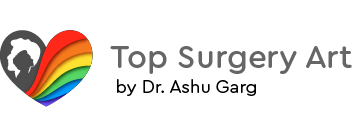WHAT TO EXPECT AFTER SURGERY
Tracheal Shave Surgery Post-Operative Care and Recovery Timeline:
Following tracheal shave surgery, a dedicated recovery period is crucial for optimal healing and achieving the desired results. Here's a breakdown of what to expect:
Healing Process and Expected Milestones:
- Initial Rest and Activity Restrictions:
- First Few Days: Prioritize rest and minimize strenuous activity for the first few days after surgery. This allows your body to focus its energy on healing.
- Gradual Return to Normal Activities: As you recover, gradually increase your activity level according to your surgeon's instructions.
- Caring for Surgical Site and Dressings:
- Incision Care: Keep the incision site clean and dry as instructed by your surgeon. This may involve gentle washing and applying prescribed ointments.
- Dressing Changes: Follow your surgeon's guidance regarding dressing changes and wound care.
- Wearing Specialized Compression Garments:
- Minimizing Swelling: In some cases, your surgeon may recommend wearing a specialized compression garment around the neck to minimize swelling and promote healing.
Scar Management Techniques and Treatments:
- Preventing Hypertrophic Scarring and Keloid Formation:
- Silicone Gel Sheets: Applying silicone gel sheets to the scar can help flatten and soften it, reducing the risk of hypertrophic scarring or keloid formation.
- Massage Techniques: Gentle massage therapy around the scar can improve blood flow and promote healing, potentially minimizing scar visibility.
- Sunscreen: Protecting the scar from direct sunlight is crucial to prevent darkening and discoloration.
Gradual Return to Normal Activities and Exercises:
- Resuming Specific Activities: Your surgeon will provide a timeline for resuming specific activities like strenuous exercise, swimming, and contact sports.
- Importance of Patience: While some improvement may be noticeable immediately, full results may take several weeks as swelling subsides and the healing process completes.
Diligence is Key: Adhering to your surgeon's post-operative instructions is crucial for a smooth recovery and achieving optimal results. This includes:
- Medications: Taking prescribed medications as directed can help manage pain and prevent infection.
- Follow-up Appointments: Attending scheduled follow-up appointments with your surgeon allows for monitoring your progress, addressing any concerns, and adjusting the recovery plan as needed.
By following these guidelines and prioritizing proper care, you can optimize your recovery journey and achieve a successful outcome from your tracheal shave surgery.
Understanding Tracheal Shave Potential Risks and Complications:
While tracheal shave surgery is generally considered a safe procedure, it's crucial to be aware of potential risks and complications:
Bleeding, Infection, and Excessive Swelling Risks:
- Bleeding: Like any surgery, there is a minimal risk of bleeding during or after the procedure. However, this risk is usually low and can be controlled with stitches or pressure.
- Infection: Although uncommon, incisions near the airway carry a slightly higher infection risk. Following post-operative care instructions and taking prescribed antibiotics can significantly minimize this risk.
- Excessive Swelling: Significant swelling and bruising are expected after the procedure and typically subside within 3-4 weeks.
Changes or Difficulties with Voice Quality and Speech:
- Voice Changes: The vocal cords are closely connected to the thyroid cartilage. During the surgery, there is a slight risk of inadvertently affecting this connection, potentially leading to temporary or permanent voice changes like:
- Hoarseness: This is a common temporary side effect that usually resolves within a few weeks.
- Muscle Spasm of the Vocal Cords (Laryngospasm): This can cause temporary voice difficulties but is typically treatable.
- Permanent Voice Changes: In rare cases, excessive cartilage removal can permanently alter voice quality. This highlights the importance of choosing an experienced and skilled surgeon.
Potential for Surgical Revision or Touch-up Procedures:
- Unsatisfactory Results: In some cases, the initial outcome may not fully
- Asymmetry: Asymmetry in the neck contour can occur, requiring additional sculpting to achieve a balanced appearance.
Strategies to Optimize Outcomes and Minimize Complications:
- Choosing an Experienced Surgeon: Opting for a well-qualified surgeon or otolaryngologist with extensive experience in tracheal shaves significantly reduces the risk of complications.
- Thorough Preoperative Consultation: Discussing your goals and expectations in detail with your surgeon allows for personalized planning and minimizes the chance of dissatisfaction with the outcome.
- Adherence to Post-operative Instructions: Following your surgeon's recovery guidelines meticulously promotes optimal healing and minimizes the risk of complications like infection or excessive scarring.
By understanding the potential risks and complications associated with tracheal shave surgery, you can make informed decisions and choose the right surgeon to ensure a safe and successful outcome.
Tracheal Shave Results and Expectations:
Tracheal shave surgery aims to achieve a smoother, more feminine neck contour by reducing the prominence of the Adam's apple. Here's what you can expect regarding results and potential outcomes:
Typical Outcomes:
- Softer Neck Contour: The primary outcome is a visibly smoother neck with a diminished Adam's apple, creating a more feminine or androgynous appearance.
- Improved Body Image and Confidence: For many individuals, this transformation can significantly enhance self-confidence and body image congruence.
Importance of Clear Communication:
Clearly communicating your desired outcome to your surgeon during the consultation is crucial. This allows them to tailor the procedure to your specific goals and ensure realistic expectations.
Realistic Expectations:
- Incomplete Elimination: It's important to understand that complete elimination of the Adam's apple is not always achievable. The extent of reduction depends on the size and shape of the thyroid cartilage and individual anatomy.
- Swelling and Healing Time: Remember that swelling and bruising are common after surgery, and the final results may take several weeks or even months to fully emerge as swelling subsides.
Factors Impacting Individual Results:
- Anatomy: The size and shape of your thyroid cartilage and surrounding tissues influence the outcome and the extent of achievable reduction.
- Skin Quality: Good skin elasticity is crucial for optimal results and minimizing scar visibility.
- Healing Process: Individual healing rates can affect the final outcome and the timeline for achieving desired results.
Potential for Complementary Procedures:
In some cases, complementary procedures like a lip lift or rhinoplasty can further enhance facial feminization and achieve a more balanced overall aesthetic. Discussing these options with your surgeon can help determine if they align with your desired outcome.
By setting realistic expectations, prioritizing clear communication with your surgeon, and understanding the factors influencing individual results, you can approach tracheal shave surgery with a clear understanding of what to expect and maximize your chances of achieving a successful and satisfying outcome.
Life After Tracheal Shave Surgery:
Tracheal shave surgery can be a transformative experience, not just physically but also emotionally. Here's how it can positively impact various aspects of life:
Emotional Impact and Renewed Sense of Gender Congruence:
For many individuals, particularly those experiencing gender dysphoria, a smoother neck contour achieved through tracheal shave surgery can significantly alleviate gender incongruence and contribute to a more aligned sense of self. This can lead to:
- Reduced Gender Dysphoria: The physical transformation can lessen the internal conflict associated with gender dysphoria, leading to greater emotional well-being.
- Increased Self-Acceptance: Embracing a physical appearance that better aligns with one's internal identity can foster greater self-acceptance and confidence.
Boost in Self-Confidence, Social Comfort and Overall Well-being:
The physical changes brought about by tracheal shave surgery can have a ripple effect on various aspects of life:
- Enhanced Self-Confidence: Feeling more comfortable and confident in one's own skin can significantly boost self-esteem and social interactions.
- Improved Social Comfort: A smoother neck contour can alleviate anxieties related to gender presentation, leading to greater comfort in social settings.
- Overall Well-being: The combined effects of reduced dysphoria, increased confidence, and improved social comfort can contribute to a significant enhancement in overall well-being.
Positive Effects on Relationships, Social Life and Career:
Feeling more confident and comfortable in one's own skin can positively impact various aspects of life:
- Strengthened Relationships: Improved self-confidence can lead to more fulfilling and authentic relationships with loved ones.
- Enhanced Social Life: Feeling comfortable and confident in social settings can encourage greater participation in social activities and foster stronger connections.
- Career Advancement: Increased confidence and self-assurance can translate into greater career success and professional fulfillment.
Connecting with Supportive Communities and Resources:
The transgender community offers a wealth of support and resources for individuals considering or undergoing tracheal shave surgery. Connecting with these communities can provide:
- Emotional Support: Sharing experiences and connecting with others who understand the journey can offer invaluable emotional support.
- Practical Guidance: Accessing resources and information from experienced individuals and organizations can provide valuable guidance throughout the process.
Ongoing Self-care, Sun Protection, and Personal Empowerment:
Following tracheal shave surgery, prioritizing self-care is crucial for optimal healing and maintaining long-term results:
- Sun Protection: Diligent sun protection of the surgical area in the early post-operative period is essential to prevent scar darkening and discoloration.
- Maintaining a Healthy Lifestyle: Healthy eating habits and regular exercise can promote overall well-being and support the healing process.
- Personal Empowerment: Embracing the physical transformation and celebrating one's authentic self is a continuous journey of personal empowerment.
Before & After Photos:
Tracheal shave surgery offers a transformative experience, and these before and after photos showcase the remarkable physical changes individuals can achieve. These photos reveal the journey from a chest that doesn't align with one's gender identity to a flat or contoured chest, reflecting a more masculine physique.
INSURANCE AND FINANCING
Tracheal Shave Potential Cost Breakdown:
The average cost for a tracheal shave procedure can range from $5,000 to $9,000 in your area. However, the final cost can vary depending on several factors:
Factors Influencing Total Costs:
- Surgeon's Fees: The surgeon's expertise, reputation, and experience significantly impact the cost. Well qualified surgeons with extensive experience in facial feminization surgery may charge more than those with less specialization.
- Facility Costs: Operating room fees at accredited hospitals or surgical centers can vary depending on location and facility overhead costs.
- Anesthesia Fees: The cost of general anesthesia, typically used during tracheal shave surgery, is an additional expense.
- Medical Tests: Preoperative medical tests, such as blood work or imaging, may add to the overall cost.
Insurance Coverage:
- Limited Coverage: Tracheal shave surgery is often considered an elective or cosmetic procedure and is therefore the cost is not always covered. However, some insurance companies do cover the cost.
- Advocating for Coverage: While uncommon, some insurance providers may offer coverage for gender affirmation surgeries, including tracheal shave, under specific circumstances. It's crucial to research your insurance plan and advocate for coverage if applicable.
Exploring Financing Options:
- Payment Plans: Some surgical practices offer patient financing plans to help manage the cost of the procedure.
- Medical Loans and Financing Companies: Medical loan options and financing companies specializing in healthcare costs can be explored to cover the expenses.
Discussing Payment Options:
Open communication with your surgeon's office regarding payment options and potential financing solutions is crucial. They can provide specific cost estimates based on your individual needs and discuss available payment plans or financing options.
Tracheal Shave Surgery Consultation: What to Expect
Ready to achieve a smoother, more feminine neck contour? Dr. Garg's practice offers FREE tracheal shave consultations to help you embark on your journey. Here's what you can expect:
Personalized Assessment:
Dr. Garg will meticulously examine your neck anatomy, delve into your desired outcomes and expectations, and assess your candidacy for tracheal shave surgery.
Exploring Surgical Options:
Together, you'll explore the potential surgical techniques available, such as open and closed tracheal shave procedures. Dr. Garg will guide you towards the approach that best aligns with your unique anatomy and goals.
Realistic Expectations and Open Communication:
Dr. Garg prioritizes open communication. He'll provide a realistic picture of what to expect, including potential risks, recovery time, and long-term results, while encouraging you to ask any questions freely.
Understanding Your Concerns:
Dr. Garg creates a safe space to openly discuss any anxieties or apprehensions you may have regarding the surgery. He will address your concerns honestly and provide reassurance throughout your journey.
Schedule Your Free Consultation Today!
Take the first step towards achieving your desired neck contour.
Contact us by calling +1 424-666-1260 or filling out our convenient online form.








